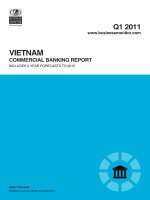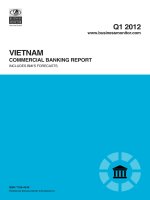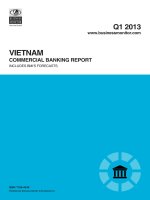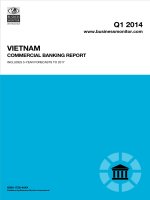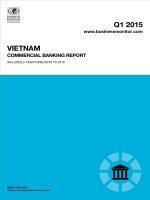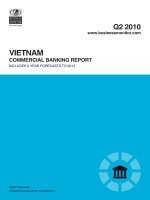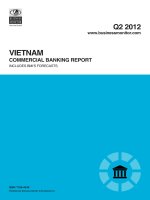Vietnam commercial banking report q3 2010
Bạn đang xem bản rút gọn của tài liệu. Xem và tải ngay bản đầy đủ của tài liệu tại đây (722.79 KB, 61 trang )
Q3 2010
www.businessmonitor.com
COMMERCIAL BANKING REPORT
ISSN 1758-454X
Published by Business Monitor International Ltd.
VIETNAM
INCLUDES 5-YEAR FORECASTS TO 2014
Business Monitor International
Mermaid House,
2 Puddle Dock,
London, EC4V 3DS,
UK
Tel: +44 (0) 20 7248 0468
Fax: +44 (0) 20 7248 0467
Email:
Web:
© 2010 Business Monitor International.
All rights reserved.
All information contained in this publication is
copyrighted in the name of Business Monitor
International, and as such no part of this publication
may be reproduced, repackaged, redistributed, resold in
whole or in any part, or used in any form or by any
means graphic, electronic or mechanical, including
photocopying, recording, taping, or by information
storage or retrieval, or by any other means, without the
express written consent of the publisher.
DISCLAIMER
All information contained in this publication has been researched and compiled from sources believed to be accurate and reliable at the time of
publishing. However, in view of the natural scope for human and/or mechanical error, either at source or during production, Business Monitor
International accepts no liability whatsoever for any loss or damage resulting from errors, inaccuracies or omissions affecting any part of the
publication. All information is provided without warranty, and Business Monitor International makes no representation of warranty of any kind as
to the accuracy or completeness of any information hereto contained.
VIETNAM COMMERCIAL
BANKING REPORT Q3 2010
INCLUDING 5-YEAR INDUSTRY FORECASTS BY TO 2014
Part of BMI’s Industry Report & Forecasts Series
Published by: Business Monitor International
Copy deadline: June 2010
Vietnam Commercial Banking Report Q3 2010
© Business Monitor International Ltd Page 2
Vietnam Commercial Banking Report Q3 2010
© Business Monitor International Ltd Page 3
CONTENTS
Executive Summary 5
Table: Levels (VNDbn) 5
Table: Levels (US$bn) 5
Table: Levels At August 2009 5
Table: Annual Growth Rate Projections 2010-2014 (%) 6
Table: Ranking Out Of 59 Countries Reviewed In 2010 6
Table: Projected Levels (VNDbn) 6
Table: Projected Levels (US$bn) 6
SWOT Analysis 7
Vietnam Commercial Banking SWOT 7
Vietnam Political SWOT 8
Vietnam Economic SWOT 9
Vietnam Business Environment SWOT 10
Business Environment Outlook 11
Commercial Banking Business Environment Ratings 11
Table: Vietnam Commercial Banking Business Environment Rating 11
Commercial Banking Business Environment Rating Methodology 12
Table: Asia Commercial Banking Business Environment Ratings 13
Global Commercial Banking Outlook 14
Asia Banking Sector Outlook 17
Table: Comparison Of Loan/Deposit, Loan/Asset & Loan/GDP Ratios 20
Table: Anticipated Developments In 2010 21
Table: Comparison Of Total Assets, Client Loans & Client Deposits (US$bn) 22
Table: Comparison Of US$ Per Capita Deposits (Late 2009) 23
Table: Interbank Rates & Bond Yields 24
Vietnam Banking Sector Outlook 25
Economic Outlook 28
Table: Vietnam Economic Activity, 2007-2014 29
Competitive Landscape 30
Market Structure 30
Protagonists 30
Table: Protagonists In Vietnam’s Commercial Banking Sector 30
Definition of the Commercial Banking Universe 30
List of Banks 31
Table: Financial Institutions In Vietnam (February 2010) 31
Company Profiles 34
Vietcombank 34
Table: Key Statistics For Vietcombank, 2004-2008 (VNDmn) 35
BIDV 36
Table: Key Statistics For BIDV, 2004-2006 (VNDmn) 37
VietinBank 38
Vietnam Commercial Banking Report Q3 2010
© Business Monitor International Ltd Page 4
Table: Key Statistics For VietinBank, 2005-2008 (VNDmn) 39
Agribank 40
Table: Balance Sheet (VNDmn, unless stated) 41
Table: Balance Sheet (US$mn, unless stated) 41
Table: Key Ratios (%) 41
MHB Bank 42
Table: Key Statistics For MHB Bank, 2006-2008 (VNDmn) 43
Habubank 44
Table: Key Statistics For Habubank, 2004-2007 (VNDmn) 45
Eximbank 46
Table: Balance Sheet (VNDmn, unless stated) 47
Table: Balance Sheet (US$mn, unless stated) 47
Table: Key Ratios (%) 47
Sacombank 48
Table: Stock Market Indicators 49
Table: Balance Sheet (VNDmn, unless stated) 49
Table: Balance Sheet (US$mn, unless stated) 50
Table: Key Ratios (%) 50
Saigonbank 51
Table: Stock Market Indicators 52
Table: Balance Sheet (VNDmn, unless stated) 52
Table: Balance Sheet (US$mn, unless stated) 52
Table: Key Ratios (%) 53
SeABank 54
Table: Balance Sheet (VNDmn, unless stated) 55
Table: Balance Sheet (US$mn, unless stated) 55
Table: Key Ratios (%) 55
BMI Banking Sector Methodology 56
Commercial Bank Business Environment Rating 57
Table: Commercial Banking Business Environment Indicators And Rationale 58
Table: Weighting Of Indicators 59
Vietnam Commercial Banking Report Q3 2010
© Business Monitor International Ltd Page 5
Executive Summary
Table: Levels (VNDbn)
Date
Total
Assets
Client
Loans
Bond
Portfolio Other
Liabilities
& Capital Capital
Client
Deposits Other
August
2008 1,659,549 1,259,980 149,817 249,752 1,659,549 217,173 1,205,966 236,408
August
2009 2,065,762 1,706,340 173,358 186,063 2,065,762 286,547 1,594,993 184,222
Change,
% 24% 35% 16% -26% 24% 32% 32% -22%
Source: BMI, SBV, regulators
Table: Levels (US$bn)
Date
Total
Assets
Client
Loans
Bond
Portfolio
Other
Liabilities
& Capital
Capital
Client
Deposits
Other
August
2008 100.4 76.2 9.1 15.1 100.4 13.1 73.0 14.3
August
2009 116.0 95.8 9.7 10.4 116.0 16.1 89.6 10.3
Change,
% 15% 26% 7% -31% 15% 22% 23% -28%
Source: BMI, SBV, regulators
Table: Levels At August 2009
Loan/Deposit Ratio Loan/Asset Ratio Loan/GDP Ratio
GDP Per Capita,
US$
Deposits Per
Capita, US$
106.98% 82.60% 107.32% 1,013 1,022
Rising Falling Rising
Source: BMI, SBV, regulators
Vietnam Commercial Banking Report Q3 2010
© Business Monitor International Ltd Page 6
Table: Annual Growth Rate Projections 2010-2014 (%)
Assets Loans Deposits
Annual Growth Rate 20 21 14
CAGR 22 27 13
Ranking 1 1 14
Source: BMI, SBV, regulators
Table: Ranking Out Of 59 Countries Reviewed In 2010
Loan/Deposit Ratio Loan/Asset Ratio Loan/GDP Ratio
11 2 10
Local Currency Asset Growth Local Currency Loan Growth
Local Currency Deposit Growth
2 1 14
Source: BMI, SBV, regulators
Table: Projected Levels (VNDbn)
2007 2008 2009e 2010f 2011f 2012f 2013f 2014f
Total
Assets 1,410,221 1,747,335 2,271,536 2,771,274 3,325,529 3,9906,34 4,788,761 5,746,514
Client
Loans
1,067,730 1,339,260 1,848,178 2,347,187 2,933,986 3,608,800 4,366,648 5,239,978
Client
Deposits
1,100,393 1,341,143 1,528,903 1,697,082 1,917,703 2,186,181 2,492,247 2,841,161
e/f = BMI estimate/forecast. Source: BMI, SBV, regulators
Table: Projected Levels (US$bn)
2007 2008 2009e 2010f 2011f 2012f 2013f 2014f
Total Assets 88.04 99.96 122.99 142.12 166.28 199.53 245.58 302.45
Client Loans 66.66 76.62 100.07 120.37 146.70 180.44 223.93 275.79
Client Deposits 68.70 76.72 82.78 87.03 95.89 109.31 127.81 149.53
e/f = BMI estimate/forecast. Source: BMI, SBV, regulators
Vietnam Commercial Banking Report Q3 2010
© Business Monitor International Ltd Page 7
SWOT Analysis
Vietnam Commercial Banking SWO
T
Strengths
! Rapid growth.
! Untapped potential.
! High savings rate of Vietnamese households.
! Increasingly open to foreign banks since WTO accession in 2007.
! The role of state-owned banks is steadily decreasing.
Weaknesses
! Domestic banks lack the capital and technology to sustain high credit growth.
! The financial accounts of many banks are still opaque.
! High exposure to real estate and stock market loans among smaller banks.
Opportunities
! The population is still under-banked.
! Income levels are likely to rise strongly over the medium term.
Threats
! The 11th National Congress of Communist Party of Vietnam in January 2011 could
result in a shift of economic policy away from further liberalisation.
Vietnam Commercial Banking Report Q3 2010
© Business Monitor International Ltd Page 8
Vietnam Political SWOT
Strengths
! The Communist Party government appears committed to market-oriented
reforms, although specific economic policies will undoubtedly be discussed at
the 2011 National Congress. The one-party system is generally conducive to
short-term political stability.
! Relations with the US are generally improving, and Washington sees Hanoi as a
potential geopolitical ally in South East Asia.
Weaknesses
! Corruption among government officials poses a major threat to the legitimacy of
the ruling Communist Party.
! There is increasing (albeit still limited) public dissatisfaction with the leadership’s
tight control over political dissent.
Opportunities
! The government recognises the threat that corruption poses to its legitimacy,
and has acted to clamp down on graft among party officials.
! Vietnam has allowed legislators to become more vocal in criticising government
policies. This is opening up opportunities for more checks and balances within
the one-party system.
Threats
! The slowdown in growth in 2009 and 2010 is likely to weigh on public
acceptance of the one-party system, and street demonstrations to protest
economic conditions could develop into a full-on challenge of undemocratic rule.
! Although strong domestic control will ensure little change to Vietnam’s political
scene in the next few years, over the longer term, the one-party-state will
probably be unsustainable.
! Relations with China have deteriorated over the past year due to Beijing’s more
assertive stance over disputed islands in the South China Sea and domestic
criticism of a large Chinese investment into a bauxite mining project in the
central highlands, which could potentially cause widescale environmental
damage.
Vietnam Commercial Banking Report Q3 2010
© Business Monitor International Ltd Page 9
Vietnam Economic SWOT
Strengths
! Vietnam has been one of the fastest-growing economies in Asia in recent years,
with GDP growth averaging 7.6% annually between 2000 and 2007.
! The economic boom has lifted many Vietnamese out of poverty, with the official
poverty rate in the country falling from 58% in 1993 to 20% in 2004.
Weaknesses
! Vietnam still suffers from substantial trade, current account and fiscal deficits,
leaving the economy vulnerable as the global economy continues to suffer in
2010. The fiscal picture is clouded by considerable ‘off-the-books’ spending.
! The heavily-managed and weak dong currency reduces incentives to improve
quality of exports, and also serves to keep import costs high, thus contributing
to inflationary pressures.
Opportunities
! WTO membership has given Vietnam access to both foreign markets and
capital, while making Vietnamese enterprises stronger through increased
competition.
! The government will in spite of the current macroeconomic woes, continue to
move forward with market reforms, including privatisation of state-owned
enterprises, and liberalising the banking sector.
! Urbanisation will continue to be a long-term growth driver. The UN forecasts the
urban population to rise from 29% of the population to more than 50% by the
early 2040s.
Threats
! Inflation and deficit concerns have caused some investors to re-assess their
hitherto upbeat view of Vietnam. If the government focuses too much on
stimulating growth and fails to root out inflationary pressure, it risks prolonging
macroeconomic instability, which could lead to a potential crisis.
! Prolonged macroeconomic instability could prompt the authorities to put reforms
on hold, as they struggle to stabilise the economy.
Vietnam Commercial Banking Report Q3 2010
© Business Monitor International Ltd Page 10
Vietnam Business Environment SWOT
Strengths
! Vietnam has a large, skilled and low-cost workforce, which has made the
country attractive to foreign investors.
! Vietnam’s location (its proximity to China and South East Asia, and its good sea
links) makes it a good base for foreign companies to export to the rest of Asia,
and beyond.
Weaknesses
! Vietnam’s infrastructure is still weak. Roads, railways and ports are inadequate
to cope with the country’s economic growth and links with the outside world.
! Vietnam remains one of the world’s most corrupt countries. Its score in
Transparency International’s 2008 Corruption Perceptions Index was 2.7,
placing it in 20th place in the Asia-Pacific region.
Opportunities
! Vietnam is increasingly attracting investment from key Asian economies, such
as Japan, South Korea and Taiwan. This offers the possibility of the transfer of
high-tech skills and knowhow.
! Vietnam is pressing ahead with the privatisation of state-owned enterprises and
the liberalisation of the banking sector. This should offer foreign investors new
entry points.
Threats
! Ongoing trade disputes with the US, and the general threat of American
protectionism, which will remain a concern.
! Labour unrest remains a lingering threat. A failure by the authorities to boost
skills levels could leave Vietnam a second-rate economy for an indefinite period.
Vietnam Commercial Banking Report Q3 2010
© Business Monitor International Ltd Page 11
Business Environment Outlook
Commercial Banking Business Environment Ratings
Table: Vietnam Commercial Banking Business Environment Rating
Limits of Potential Returns Data Score, out of 10 Ratings score, out of 100
Total assets, end 2008 US$100.0mn 5 Market Structure 60
Growth in total assets, 2008-2013
6
Growth in client loans, 2008-2013
7
GDP per capita, 2008 US$1,035 1 Country Structure 48
Tax 5.9 6
GDP volatility 1.4 9
Financial infrastructure 3.0 3
Risks to Realisation of Returns
Regulatory framework and development 4.5 5 Market Risk 40
Regulatory framework and competitive
landscape 5.0 5
Moody’s rating for local currency
deposits 2.0 2
Long-term financial risk 6.0 6 Country Risk 50
Long-term external risk 3.3 3
Long-term policy continuity 7.0 7
Legal framework 3.9 4
Bureaucracy 4.9 5
Commercial Banking Business Environment Rating 52
Source: BMI
Vietnam Commercial Banking Report Q3 2010
© Business Monitor International Ltd Page 12
Commercial Banking Business Environment Rating Methodology
Since Q108, we have described numerically the banking business environment for each of the countries
surveyed by BMI. We do this through our Commercial Banking Business Environment Rating (CBBER),
a measure that ensures we capture the latest quantitative information available. It also ensures consistency
across all countries and between the inputs to the CBBER and the Insurance Business Environment
Rating, which is likewise now a feature of our insurance reports. Like the Business Environment Ratings
calculated by BMI for all the other industries on which it reports, the CBBER takes into account the
limits of potential returns and the risks to the realisation of those returns. It is weighted 70% to the former
and 30% to the latter.
The evaluation of the Limits of Potential Returns includes market elements that are specific to the
banking industry of the country in question and elements that relate to that country in general. Within the
70% of the CBBER that takes into account the Limits of Potential Returns, the market elements have a
60% weighting and the country elements have a 40% weighting. The evaluation of the Risks to the
Realisation of Returns also includes banking elements and country elements (specifically, BMI’s
assessment of long-term country risk). However, within the 30% of the CBBER that take into account the
risks, these elements are weighted 40% and 60%, respectively.
Further details on how we calculate the CBBER are provided at the end of this report. In general, though,
three aspects need to be borne in mind in interpreting the CBBERs. The first is that the market elements
of the Limits of Potential Returns are by far the most heavily weighted of the four elements. They account
for 60% of 70% (or 42%) of the overall CBBER. Second, if the market elements are significantly higher
than the country elements of the Limits of Potential Returns, it usually implies that the banking sector is
(very) large and/or developed relative to the general wealth, stability and financial infrastructure in the
country. Conversely, if the market elements are significantly lower than the country elements, it usually
means that the banking sector is small and/or underdeveloped relative to the general wealth, stability and
financial infrastructure in the country. Third, within the Risks to the Realisation of Returns category, the
market elements (ie: how regulations affect the development of the sector, how regulations affect
competition within it, and Moody’s Investors Service’s ratings for local currency deposits) can be
markedly different from BMI’s long-term risk rating.
Vietnam Commercial Banking Report Q3 2010
© Business Monitor International Ltd Page 13
Table: Asia Commercial Banking Business Environment Ratings
Limits of Potential
Returns
Risks to Potential
Returns Overall
Market
Structure
Country
Structure
Market
Risks
Country
Risks Rating Ranking
Bangladesh 43.3 57.5 30.0 46.0 46.2 49
China 90.0 62.5 56.7 64.0 73.6 10
Hong Kong 66.7 87.5 70.0 82.0 75.7 8
India 80.0 40.0 53.3 60.0 62.0 30
Indonesia 66.7 60.0 76.7 48.0 62.6 29
Japan 30.0 77.5 63.3 80.0 56.3 31
Malaysia 66.7 77.5 76.7 70.0 71.5 13
Pakistan 30.0 47.5 56.7 42.0 40.3 53
Philippines 50.0 47.5 56.7 52.0 50.5 46
Singapore 66.7 85.0 96.7 84.0 78.5 4
Sri Lanka 13.3 45.0 36.7 52.0 32.0 58
South Korea 80.0 85.0 76.7 64.0 78.1 6
Taiwan 70.0 77.5 83.3 64.0 72.6 11
Thailand 63.3 67.5 80.0 64.0 66.6 18
Vietnam 60.0 47.5 40.0 50.0 52.3 40
US 80.0 85.0 100.0 80.0 83.8 2
Scores out of 100, with 100 the highest. Source: BMI
Vietnam Commercial Banking Report Q3 2010
© Business Monitor International Ltd Page 14
Global Commercial Banking Outlook
Three Key Risks To Global Banking
While the global banking sector is recovering robustly, there are still three major risks that will remain
prevalent over the rest of 2010 and into 2011: the eurozone’s fiscal and economic ructions, the potential
for a burst asset bubble in China and greater global regulation.
The global banking sector continues to heal from a tumultuous 2007-2009. Major banks across the world
have taken advantage of generally favourable conditions, including central bank and government support,
a steep yield curve allowing for profitable short-term borrowing and long-term lending, a stabilisation in
asset prices, and a recovery in global risk appetite. Banks are by no means out of the woods however, and
we continue to forecast a deceleration in the US and Chinese economies and an overall global slowdown
from 3.2% growth in 2010 to 3.1% in 2011. This, along with household balance sheet rebuilding in most
developed states, will keep banks far from staging a recovery to pre-crisis loan growth levels. We
continue to be more optimistic about the prospects for banking sectors in the emerging markets, which
have held up well during the recession and will continue to take advantage of relatively low leverage and
penetration levels to grow throughout the coming decades. This is especially true for underserved frontier
markets, such as those in Sub-Saharan Africa.
Nonetheless, we still believe there are massive risks for the banking sector in H210 and going into 2011.
These include: the potential for a major internal dislocation in the eurozone, as shown by the crisis in
Greece; the increasing risk of a property-driven asset price meltdown in China; and the uncertainty over
greater banking sector regulation by governments worldwide.
Eurozone: Internal Dislocations
Economic tail risks appear to be
increasing in Europe in our view, with
question marks not only hanging over
Greece, but over the sustainability of
the eurozone. The big issues, including
the requirement for a fiscal union,
greater labour mobility and reducing
cross-border
productivity/competitiveness
differentials are not resolvable in the
short term, if at all. In the absence of
floating exchange rates, most eurozone
members’ labour costs are going to
have to be reduced via internal devaluations, which will result in short-term economic dislocations and,
A Eurozone Default Could Have Far-
Reaching Consequences
Domestic Banks’ Exposure To PIIGS (US$bn)
Source: Bank for International Settlements
Vietnam Commercial Banking Report Q3 2010
© Business Monitor International Ltd Page 15
potentially, greater default rates. Internal devaluation would not be problematic were it not for the large
debts of several member states. Destabilising growth and reducing the price level would essentially
increase the ratio of debt-to-GDP in several of the weaker states and this is justifiably raising fears of
default across the eurozone.
The problem for the banking sector is that in the first years of the eurozone, risk premiums in each
country of the monetary union fell sharply as states such as Greece were suddenly considered part of the
same currency bloc as Germany. Banks in more developed states with large capital bases, such as
Germany and France, lent to states on the periphery, such as Spain, Portugal and Greece. The 2010 euro
crisis has driven up risk premiums, which has left entire banking sectors in the lurch. Between them, the
British, French and German banking systems have US$2.04trn in exposure to Portugal, Italy, Ireland,
Greece and Spain (the ‘PIIGS’); while domestic banks are heavily exposed to their countries’ sovereign
bonds. Taken together, a sovereign default and a domestic banking crisis in any eurozone member would
trigger higher risk premiums across Europe and could test the solvency of the entire European banking
system. On a global scale, this could trigger a bout of risk aversion to rival what followed the Lehman
Brothers crisis.
China: Beware The Dragon
The Chinese economy has shown
tremendous resilience during the
recession, largely due to unprecedented
levels of government stimulus
offsetting weaker global demand
growth for Chinese exports. Much of
this stimulus was channelled via
government-directed bank lending and
a sizeable amount of it has found its
way into property investment.
However, as 2010 unfolds and liquidity
tightening measures are increased, we
expect loan growth in China to slow, revealing the effects of the bad loans made in recent years. More
pointedly, we are increasingly concerned about the prospect of financial turbulence if the property market
bubble bursts. With credit still in abundant supply, we believe that non-performing loan (NPL) ratios are
likely to remain low for the time being. The average NPL ratio hit a nadir of 1.58% in December 2009.
But we think that banks are likely keeping some poor credit risks liquid with increasing amounts of debt,
which, along with innovative accounting practices, is helping to keep the NPL ratio low. At some point,
which we believe will come in the latter stages of 2010, loans to property developers and manufacturers
may have to be called in if the central bank is forced to tighten liquidity, which will cause the NPL ratio
to spike.
New Loans Still Elevated
China – New Loans (CNYbn)
Source: People’s Bank of China, BMI
Vietnam Commercial Banking Report Q3 2010
© Business Monitor International Ltd Page 16
Of course, with the state banks accounting for the bulk of new lending in China, we believe the
government will support the system if banks get into trouble. As has been the case in the aftermath of
rising NPLs following government-driven lending booms, Beijing is likely to pick up the tab by taking
the loans off the balance sheets of state-owned banks and issuing bonds to pay for them. Still, any
shakeup in the Chinese banking sector presents major contagion risks elsewhere in the world, by raising
risk premiums and potentially derailing Chinese growth, which has been at the heart of the global
recovery.
Regulation Coming To The Fore
Tighter banking regulation is certain to be a major theme (and risk) in 2010-2011, as we have discussed in
previous Global Banking Outlooks. While we expect new financial regulations to affect large investment
banks more than traditional lenders such as commercial and regional banks, they are likely to have an
impact on the whole financial arena. Under bills being considered in the US Congress, for example,
financial firms would be forced to keep greater cushions against losses and the government would
exercise greater regulatory control over mortgages and derivatives. More sweeping reforms would
essentially reintroduce the Glass-Steagall Act, separating investment and commercial banking operations.
On a global level, there has been increasingly serious discussion about the imposition of Tobin financial
transaction taxes, higher capital adequacy ratio requirements, increased regulatory oversight of a vast
array of banking functions and a tax on bank’s profits. The outcome of such proposals is made all the
more unpredictable by populist rhetoric from politicians, many of whom see banks as easy targets.
Ultimately, tighter regulation may lead to a safer but less profitable banking system, although this will
depend on the extent to which banks are able to circumvent new regulations. For example, to deal with
bans on high-risk activities, banks are likely to increasingly resort to spinning off risky assets to separate
companies, thereby dissociating themselves from the risk on the face of it but retaining a potential
relationship with the profits it could generate.
Vietnam Commercial Banking Report Q3 2010
© Business Monitor International Ltd Page 17
Asia Banking Sector Outlook
Where The Opportunities And Risks Lie
With the Asian economic recovery maturing, we examine the relative health of the banking systems
within the region to discover where the opportunities and risks lie. We expect the Philippines and
Indonesia to lead the way in banking sector expansion in 2010 and 2011 due to their relatively healthy
balance sheets. South Korea stands out as being particularly vulnerable to a renewed bout of risk
aversion.
As the Asian economic recovery consolidates and the dust of the global financial crisis settles, we have
taken a broad look at the health of the region’s banking sectors to assess which are most likely to facilitate
a stronger economic recovery and which could impede it in H210 and 2011. This also helps us to gauge
the potential for any instability ahead as a result of a slowdown in Chinese and US growth in 2011.
To develop a ranking of banking sector risk in Asia, we looked at three metrics:
• Loan-to-deposit ratios: give an indication of how conservative or aggressive lending practices
are.
• Equity-to-asset ratios: show how solid capital bases are.
• Total banking sector assets relative to GDP: a guide to the amount of room for expansion and
the potential economic consequences of any banking sector instability.
With equal weighting assigned to each
metric, we ranked the 12 Asian
countries covered as shown in the chart
below, with the Philippines appearing
to be in the most solid shape and South
Korea as the most risky.
In general, the more stable and
underleveraged the banking system, the
greater the expected increase in credit,
in our view. We have also looked at our
forecasts for the percentage change in
asset growth in 2010 compared to 2009,
again ranking each country. Below is a
Regional Risk Spectrum
Asia – Relative Risk Based On Loan/Deposit,
Equity/Asset & Asset/GDP Ratios
Note: higher number = higher risk. Source: BMI
Vietnam Commercial Banking Report Q3 2010
© Business Monitor International Ltd Page 18
scatter diagram of the rankings in expected change in asset growth (x-axis) in 2010 compared to 2009 and
banking sector stability (y-axis). A number of interesting observations can be made.
South Korea: Liquidity A Risk
South Korea is on its own in terms of
the potential for instability, with the
most risky sector in the region. With a
relatively low equity buffer of 6.7% of
assets, compared to a regional average
of 8.6%; a loan-to-deposit ratio of
120% (the only country in the region
exceeding 100%); and a relatively large
banking system in relation to GDP
(156% at the end of 2009), we believe a
renewed bout of global risk aversion
could put local banks under serious
stress, as in 2008, as ‘hot money’ flows out of the highly leveraged banking system. While we have
confidence in the solvency of the South Korean banking system, liquidity issues could force the Bank of
Korea to use temporary capital injections. Furthermore, with the banking system likely to expand credit
this year (we expect client loans to grow by 6.2% in 2010, up from +2.5% in 2009, and total asset growth
to rise from 5.0% to 7.8%), making South Korea an outlier on the chart, this adds to the risk of instability.
The overleveraged nature of the banking system has not gone unnoticed by officials. Local regulators
have urged banks to reduce their loan-to-deposit ratios to 100% by 2013.
China: A Damage Limitation Game
The second point to note is that while
China scores poorly in terms of banking
sector stability (we have written many
times about the risks faced by Chinese
banks as a result of the credit binge in
2009), we do expect loan growth to
shrink in 2010 as the regulators become
concerned with non-performing loans
(NPLs) and the government and central
bank aim to keep a lid on inflation,
particularly in asset prices. China has
the lowest equity buffer in the region at
South Korea Looks Vulnerable
Asia – Asset Growth v Stability
Source: BMI
Where Is The Leverage?
Asia – Loans, % of deposits
Source: BMI
Vietnam Commercial Banking Report Q3 2010
© Business Monitor International Ltd Page 19
2.9% of assets and we expect the remainder of 2010 and 2011 to be characterised by lower loan growth
and raising of equity. We forecast total banking sector assets growing by 10.0% in 2010 and by 8.0% in
2011, after rising by 26.2% in 2009.
Indonesia And The Philippines:
Ready To Support Growth
The Indonesian and Philippine banking
systems both score solidly in terms of
loan exposure, leverage and asset-to-
GDP ratios. Indonesia has a solid loan-
to-deposit ratio of 73% and an equity-
to-asset percentage of 10.7%, while
total banking sector assets are just
48.0% of GDP. Indonesia has
weathered the economic downturn well
and we expect commercial banks to
increase profitability in the coming
quarters in light of the high margins and projected rise in loan growth. We expect total client loans to
increase by 11.0% in 2010. With the benefit of the profitability enhancing wide margins that were
maintained in 2009, and in our view NPLs have likely peaked, banks in Indonesia appear to be in a good
position to spread their wings this year and next.
Similarly, the Philippines has the
second lowest loan-to-deposit ratio in
the region behind Hong Kong, at 67%,
and a healthy 10.9% of assets in equity,
which should support banking sector
asset expansion in 2010 and beyond.
Strong demand for consumer loans
should lead to loan growth of 10.4%
and 11.5% in 2010 and 2011
respectively, up from the 9.0% in 2009.
This would boost the total asset base of
universal and commercial banks by
10.2% in 2010, accelerating to 11.4%
the following year. The conservative lending practices in the Philippine banking sector in recent years,
with a large proportion of loans going to government bonds, look set to change as banks take advantage
of the economic recovery in 2010 by extending more loans to companies and individuals.
Hong Kong Out On Its Own
Asia – Banking Sector Assets, % of GDP
Source: BMI
China Needs An Equity Boost
Asia – Equity, % of total banking sector assets
Source: BMI
Vietnam Commercial Banking Report Q3 2010
© Business Monitor International Ltd Page 20
Sri Lanka: Facing Crowding Out Issues
While the Sri Lankan banking sector appears to be in relatively good shape, we do not expect asset
growth acceleration this year, and in fact forecast total asset growth to slow from 12.5% in 2009 to 9.5%
in 2010. A large number of commercial bank deposits have been locked in at high rates set under the
recent high level of inflation and we expect government borrowing requirements to remain high in 2010
as the Rajapaksa administration’s fiscal profligacy crowds out private sector credit creation. The former
will keep lending rates elevated, while the latter will divert assets away from the private sector.
Hong Kong: Risks May Be Understated
It should also be noted that although Hong Kong’s banking sector is well capitalised, with an 11.9%
equity buffer, and the loan-to-deposit ratio is the lowest in the region, giving it a solid ranking in our risk
ratings, it remains heavily exposed to a bloated property market. While we forecast loan growth in 2010
to be higher than in 2009, this is largely due to the sharp contraction last year. A bursting of the property
bubble, which could result from tighter monetary policy in the US or mainland China, could trigger a
property price downturn causing instability in the local banking system and more contraction in credit.
Table: Comparison Of Loan/Deposit, Loan/Asset & Loan/GDP Ratios
Loan/
Deposit
Ratio % Rank Trend
Loan/
Asset
Ratio % Rank Trend
Loan/
GDP
Ratio % Rank Trend
Bangladesh 81.7 47 Rising 65.1 21 Falling 44.1 46 Rising
China 69.5 51 Rising 52.6 34 Rising 131.2 11 Rising
Hong Kong 51.2 59 Falling 30.8 56 Rising 200.5 2 Rising
India 79.5 40 Falling 62.3 17 Rising 48.5 37 Rising
Indonesia 72.9 48 Falling 58.9 26 Falling 28.3 52 Rising
Japan 74.6 50 Falling 53.2 35 Falling 89.7 20 Rising
Malaysia 75.6 44 Falling 57.1 27 Rising 112.1 12 Rising
Pakistan 67.9 41 Falling 49.7 53 Falling 24.8 56 Falling
Philippines 66.5 54 Falling 50.1 38 Rising 36.1 48 Rising
Singapore 71.9 45 Falling 39.8 47 Falling 110.6 9 Rising
Sri Lanka 70.3 46 Falling 53.6 30 Falling 23.7 54 Falling
South Korea 122.7 8 Falling 70.6 15 Rising 110.1 13 Falling
Taiwan 75.1 35 Falling 59.8 19 Falling 154.7 5 Rising
Thailand 95.3 25 Falling 64.5 11 Falling 73.8 26 Falling
Vietnam 120.9 5 Rising 81.4 3 Rising 112.3 10 Rising
US 79.0 42 Falling 55.6 31 Falling 51.1 41 Falling
Source: Central banks, regulators, BMI
Vietnam Commercial Banking Report Q3 2010
© Business Monitor International Ltd Page 21
Table: Anticipated Developments In 2010
Loan/Deposit
Ratio, % Trend
Loan Growth,
US$bn
Deposit
Growth,
US$bn
Residual,
US$bn
Bangladesh 83.8 Rising 7.1 7.2 -0.1
China 69.5 Falling 623.4 896.4 -273.0
Hong Kong 50.2 Falling 21.1 57.7 -36.6
India 78.2 Falling 158.7 217.5 -58.8
Indonesia 73.5 Rising 32.8 42.8 -10.0
Japan 75.7 Rising -304.7 -492.4 187.7
Malaysia 76.3 Rising 47.0 58.8 -11.8
Pakistan 67.2 Falling 0.8 1.1 -0.3
Philippines 64.4 Falling 8.3 15.8 -7.5
Singapore 72.5 Rising 27.9 35.9 -8.0
Sri Lanka 70.3 Falling 1.8 2.5 -0.8
South Korea 122.1 Falling 180.5 151.8 28.8
Taiwan 77.7 Rising 55.4 44.8 10.6
Thailand 95.8 Rising 15.7 15.4 0.3
Vietnam 138.3 Rising 20.3 4.2 16.1
US 75.1 Falling -145.7 276.8 -422.5
Note: Incorporates estimated economic data and projected banking data. Source: Central banks, regulators, BMI
Vietnam Commercial Banking Report Q3 2010
© Business Monitor International Ltd Page 22
Table: Comparison Of Total Assets, Client Loans & Client Deposits (US$bn)
2009 2008
Total Assets Client Loans
Client
Deposits Total Assets Client Loans
Client
Deposits
Bangladesh 60.6 39.5 48.3 50.6 33.0 42.1
China 11,853.4 6,234.0 8,964.5 9,389.7 4,684.6 7,003.0
Hong Kong 1,370.6 422.8 825.8 1,384.1 423.8 781.9
India 1,073.3 668.6 840.8 896.5 547.9 674.9
Indonesia 259.8 153.0 209.9 203.1 120.5 161.6
Japan 8,614.6 4,585.4 6,146.3 8,976.7 4,778.8 6,166.8
Malaysia 397.3 227.0 300.1 367.7 207.3 270.0
Pakistan 79.9 39.8 56.8 80.0 45.3 53.3
Philippines 117.9 59.1 88.7 106.0 53.1 78.0
Singapore 505.0 200.9 279.6 464.5 189.1 241.5
Sri Lanka 19.2 10.3 14.6 17.3 10.2 12.5
South Korea 1,450.9 1,023.7 834.3 1,407.9 920.9 693.6
Taiwan 980.8 586.0 780.2 901.8 567.8 694.6
Thailand 310.5 200.3 210.1 289.5 195.9 202.7
Vietnam 123.0 100.1 82.8 100.0 76.6 76.7
United States 13,109.5 7,286.2 9,226.8 13,853.2 7,875.9 9,035.7
Source: Central banks, regulators, BMI
Vietnam Commercial Banking Report Q3 2010
© Business Monitor International Ltd Page 23
Table: Comparison Of US$ Per Capita Deposits (Late 2009)
GDP Per Capita
Client Deposits,
per capita
Rich 20% Client
Deposits, per
capita
Poor 80% Client
Deposits, per
capita
Bangladesh 618 273 1,335 83
China 3,500 4,592 26,414 1,651
Hong Kong 29,877 59,899 467,985 29,249
India 1,160 563 2,831 177
Indonesia 2,278 645 3,539 221
Japan 40,129 35,993 192,984 12,061
Malaysia 7,154 8,018 42,409 2,651
Pakistan 949 243 1,388 87
Philippines 1,791 646 3,883 243
Singapore 37,148 41,067 228,620 14,289
Sri Lanka 2,228 528 3,004 188
South Korea 18,822 20,733 67,588 4,224
Taiwan 16,363 25,306 134,763 8,423
Thailand 4,192 3,094 12,980 811
Vietnam 1,013 1,137 3,763 235
US 46,365 23,696 120,030 7,502
Source: Central banks, regulators, BMI
Vietnam Commercial Banking Report Q3 2010
© Business Monitor International Ltd Page 24
Table: Interbank Rates & Bond Yields
3-Month Interbank
Rate %
Current Account %
of GDP, 2010f
Budget balance %
of GDP, 2010f End-2008 Late 2009
Bangladesh 3.2 -5.4 na na
China 3.7 -2.1 1.78 1.71
Hong Kong 9.5 -2.5 0.90 0.18
India -2.0 -6.5 4.65 4.00
Indonesia 2.3 -1.3 12.13 6.60
Japan 3.0 -6.5 0.77 0.36
Malaysia 12.6 -5.8 3.34 2.07
Pakistan -7.2 -5.3 15.27 12.35
Philippines 5.9 -3.5 5.38 3.70
Singapore 19.6 -1.3 0.80 0.25
Sri Lanka -3.7 -7.9 18.50 10.50
South Korea 3.1 -3.7 3.93 2.79
Taiwan 8.3 -4.2 0.66 0.56
Thailand 6.0 -1.6 2.95 1.17
Vietnam -9.9 -4.9 7.27 8.20
US -2.8 -8.9 1.75 0.49
na = not available. Note: Incorporates actual financial markets data, estimated economic data and projected banking
data. Source: Central banks, regulators, BMI

